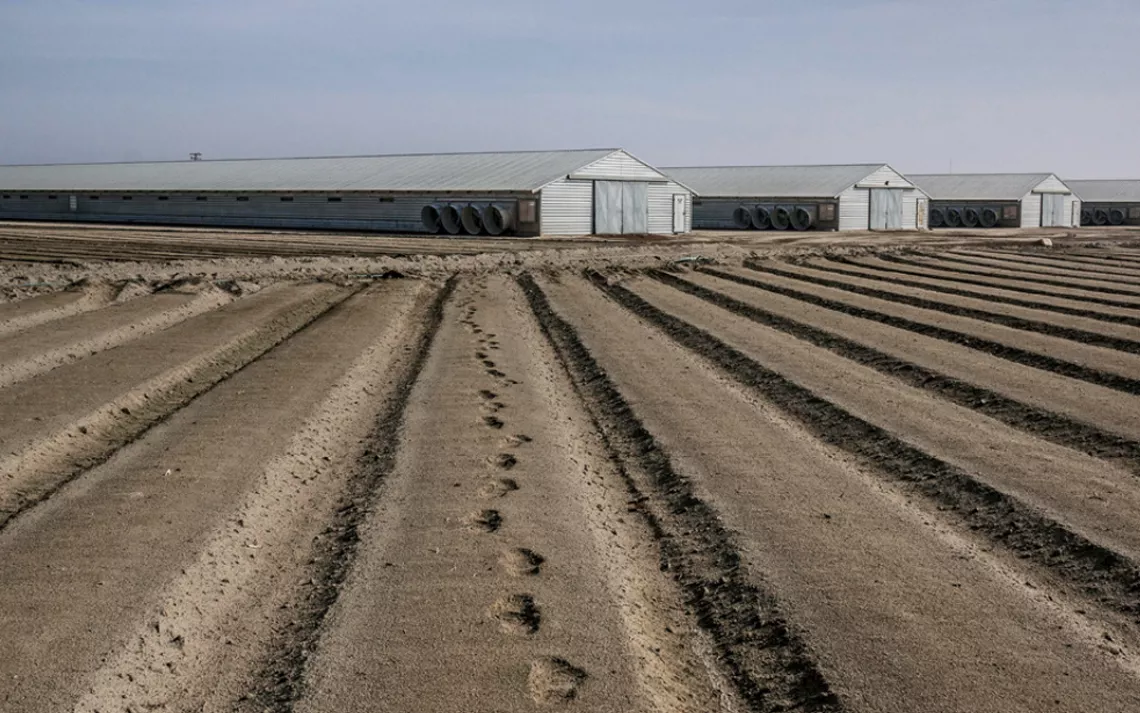Not Your Grandparents' Drought

An abandoned tomato field in Fresno County, California. For a second year, Central Valley farmers will receive no water from federal projects. | Photo by Matt Black/The New York Times/Redux
It was no joke. On April 1, California governor Jerry Brown accompanied state surveyors on their annual measurement of the Sierra Nevada snowpack, which provides 30 percent of the state's water. In the past, the snowpack on this date has averaged more than five feet, but as California entered its fourth year of drought, the governor stood not on snow but on bare grass. The snowpack across the Sierra Nevada measured under two inches—an official with the Department of Water Resources joked that the mountains should be called "Sierra Nada."
With reservoirs low, groundwater depleted, and rivers trickling instead of roaring, the Golden State is turning brown. Drought-stressed trees are infested by bark beetles, leading to a doubling of their death rate and a grim outlook for fire season. Native salmon flounder in warm, shallow rivers, resulting in 95 percent mortality for Chinook eggs and fry. Even the grid is taking a hit, as hydroelectric dams fail to generate their usual amount of electricity. Over the past three years, the shortfall in hydropower has increased greenhouse gas emissions from California power plants by 8 percent.
Despite such worrying indicators, the state has been slow to respond. Last year, Governor Brown asked citizens to voluntarily reduce their water use by 20 percent, but they cut less than half that much. Legislators banned restaurants from serving water to people who didn't ask for it, but that didn't make much of a dent. Last spring, Brown finally got serious, ordering a variety of water conservation measures, including a mandatory 25 percent reduction by water agencies throughout the state. The big target is lawns and landscaping, which account for half of household water use; campuses, golf courses, cemeteries, and street medians are also singled out for cuts.
Yet the biggest user of California water is agriculture, which consumes 80 percent of the state's "developed" water (from dams and reservoirs) while generating less than 2 percent of its gross domestic product. And growers have certainly felt some of the pain of the drought, with sharp reductions in state and federal water allocations. Last year, 400,000 acres of farmland were left fallow due to the water shortage, and the number is expected to increase this year.
But because there are no limitations on the use of groundwater, many farmers are digging deep wells to suck up millennia-old water from aquifers. In normal years, groundwater is believed to account for about 40 percent of the freshwater used in California (the numbers are fuzzy since groundwater use isn't measured or monitored). Now groundwater consumption has sharply increased, with some estimating that it could account for 75 percent of the state's total water use this year.
Even though parts of the fertile Central Valley are subsiding by as much as a foot a year due to groundwater depletion, the state has given itself 25 years to solve the problem. "We expect to bring our groundwater basins into balance over time, and we're not going to be able to do that during a drought," says Mark Cowin, director of the Department of Water Resources.
Others feel more urgency. "There's no snow, there's no snowmelt, and there's very little water in the reservoirs," says Jay Famiglietti, a senior water scientist at NASA's Jet Propulsion Lab. "Thirty years from now, who knows how much groundwater will be left?"
Exhausting the hydrological savings account would be foolhardy under any circumstances, but critics of state water policy note that half of California's agricultural water is used on crops that are sent overseas. Two thirsty crops in particular have gained notoriety: almonds, which swallow close to 9 percent of the state's water, and alfalfa (grown as feed for cattle), which devours more than 15 percent. Eighty percent of the state's almonds are grown for export, as is about half of the alfalfa. "We're exporting alfalfa to China in container ships, and most of that is grown in the desert," notes Robert Wilkinson, a water policy professor at the University of California, Santa Barbara. "What choices are we making with the water we're using?"
Drought has always been part of the climate cycle in California, which has the most variable rainfall in the nation. For hundreds of years, the state has experienced very low rainfall roughly a third of the time. But now there's more to it, explains Noah Diffenbaugh, a senior fellow at the Woods Institute for the Environment at Stanford University. "Temperature plays a critical role in drought risk in California." In 2014, he notes, the state experienced the warmest winter ever recorded. "We have strong scientific evidence that global warming has increased the probability of the conditions we're experiencing now."
In the past, Diffenbaugh points out, California had wet years and dry years, warm years and cool years, but the variables operated independently, with hot and dry overlapping only about 25 percent of the time. As the climate warms, there's now an 80 percent likelihood that a dry year will also be a hot year. That overlap makes for a thirstier environment; it also means that precipitation isn't stockpiled as snow for use in the dry summer months.
All of which means that California's water crisis is not a short-term problem. "It will rain again in California," Wilkinson observes. "But we could cycle wet and the same actions would be needed. We need to get people out of the mind-set that you just need to suffer until the next rain."
What You Can Do
The best water-saving measures are those you don't have to think about, like replacing your lawn with drought-tolerant landscaping. You'll also save water every day by getting efficient, modern toilets; a front-loading washing machine; low-flow showerheads; and aerators for your faucets.
 The Magazine of The Sierra Club
The Magazine of The Sierra Club



